Introduction
Learn about distribution, wholesalers, retailers and customers, shops, and direct marketing.
Audio Episode
Practice Booklet (For the Entire Mini-Series)
Business English Marketing … by English Plus Podcast
Episode Transcript
Welcome to episode six in our business English marketing mini series. In this episode, we will talk about place. The four PS are product price, place, and promotion. And this is the third P place we will talk about distribution, wholesalers, retailers, and customers. We will talk about shops, the different types of shops and direct marketing.
[00:00:26] And before we start, let me remind you that if you want to practice the things you’re learning, you can use the PDF practice booklet that I’ve provided with the mini series. You can find the booklet on our website, English plus podcast.com or on our Patrion page. And now without further ado, let’s start talking about distribution, wholesalers, retailers, and customers.
[00:00:45] Now of course, to talk about the product it starts with the producers, maybe these are factories or companies. It depends, you know, the product can be a physical product and can be a service and can be software. For example, it doesn’t always have to be a physical product, but anyway, the people who create this product or service, these are called producers.
[00:01:05] And then these producers may sell directly to customers, but usually what happens is that the producers now say maybe a factory, because that’s easier to understand if a factory makes a kind of food. Let’s say usually you don’t buy the food product directly from the factory. You may be in some places you can, but generally.
[00:01:26] You don’t do that. The producer, the factory sells the products, sells large quantities of the products to wholesalers. And that is what we call the distribution network. The distribution network goes from wholesalers to retailers and wholesalers buy large quantities of the products. And then they sell those.
[00:01:46] In turn to retailers, to those who buy smaller quantities of the products that say, for example, you are a wholesaler, you buy large quantities and then you sell to shops. You sell to grocery stores, maybe you even sell to supermarkets, but it’s still, you don’t sell directly to customers. You sell to other sellers, but you are a wholesaler and then you sell it to the next level, to this level that is going to sell directly to customers.
[00:02:14] These are called the retailers and this network, but when the wholesalers and the retailers, we call it the distribution network. Then finally we have the distribution channel when the products can be bought by the customers and usually from retailers. But again, that doesn’t happen all the time.
[00:02:33] Sometimes customers buy their products directly from the producers, but this channel that takes the product to the customer is called the distribution channel. Now, why am I talking about this? Because it is important. When you want to think about marketing a product you want to think about. The distribution network and the distribution channel.
[00:02:53] Do you have a clear distribution network? Have you thought about that? Have you thought this through, maybe it’s not your job as a marketing manager to do that. Of course there are other departments who take care of that, but do you know what it is? Do you know how it works? Do you know how much it costs?
[00:03:08] Do you know how fast your product can get to the customer? Because that is important for you to know as a marketing manager, maybe you don’t need to go into all the details because that’s not your job, but you need to know how the products reach the customers in what shape, and maybe along the way there is packaging along the way who knows, maybe packaging doesn’t happen all in the factory.
[00:03:29] Maybe it does, but regardless of the packaging, let’s focus on the distribution network. Do you know the distribution network? Do you have an effective distribution network that gets the products to the customers in time? And what about the distribution channels to the customers themselves? Do you have good distribution channels?
[00:03:47] Do you have different distribution channels or is it only one. All these questions are for you to ask to know, maybe you don’t plan these things. Maybe you don’t execute these things. That’s fine, but you need to know about them. You need to know every detail about them. Actually, if you work in marketing, let’s talk about the idea of wholesalers and retailers.
[00:04:06] Now, a wholesaler or retailer selling a particular type of product. For example, cars is a dealer. Or especially in the case of computer equipment or telecommunication services is called a reseller. Now you’ve heard of that. An Apple reseller, a Samsung reseller, et cetera, they call it a reseller, but basically a wholesaler or a retailer.
[00:04:26] In this case, selling specialty cars, they call them a dealer. Now wholesalers and retailers are distributors, are people or companies, obviously that distribute the product from the producer to the customer. And distributors may be referred to sometimes times disapprovingly as middlemen. Come on, buy something directly from a producer instead of from a distributor in order to save money, they may say that they are cutting out the middleman.
[00:04:55] Sometimes you make cut out the middleman to save money. Now, maybe this happens with some stores. For example, some retailers might cut out the middleman and go directly to the producer, but sometimes producers themselves refuse to sell retailers because they prefer to work this way. They sell everything to wholesalers and wholesalers sell to retailers, but some producers.
[00:05:17] Don’t mind, some producers open the door for retailers or even customers to go and buy directly. And if you do that, you’re cutting out the middleman. And when you cut out the middleman, you save money. So here in a marketing context, you need to know these things you need to know. Can people cut out the middleman?
[00:05:34] I mean, if you are sending some messages in your marketing campaign, but then you know, your customers figure out that they can cut out the middleman and they can save money by going directly to the factory. And actually the factory sells the products directly to customers, and you’ve been marketing this thing in another way, totally different way and a totally different price maybe.
[00:05:54] And that is so dangerous. If you’re marketing your products at a price and then customers can come to the factory and buy it at a lower price, that’s the problem, right? Or maybe it’s not. But at least unique to know these are questions you need to know as a marketing manager or if you’re just working in marketing.
[00:06:10] So that being said, let’s move on to talk about shops, a shop that is usually used in British English. A store that is usually used in American English may be referred to technically, for example, by a maker of goods as a retail outlet or sales outlet. I remember we’re talking about the shops in the context of marketing.
[00:06:29] So they may be called by the maker of the goods by the producer. They may be called the retail outlet or sales outlet. Now, here are some types of shops. Well, because not all shops are the same. We have what we call a chain store. What is a chain store? A chain store is a shop that is part of a group of shops all with the same name.
[00:06:48] That’s what we call a chain store. We have a convenience store. Now the convenience store is a shop in a town that is open long hours. That’s what we call convenience store. You can find it sometimes 24 seven, they open 24 seven. Sometimes they open like for 20 hours a day or something. That’s what we call convenience does that they’re usually found in towns, not in big cities.
[00:07:08] And then we have the discounter, a discounter store or discounter shop that is a wholesaler or retailer with very low prices. It can be a wholesaler or a retailer doesn’t matter, but it is a discounter. The prices there are very low. And then we have the department store. The department store is a very large shop or store, and that is usually found in town centers.
[00:07:31] And then we have the hypermarket. Now the hypermarket is a very large or store with a wide variety of goods, usually outside of town, because it usually needs a big area. So it is usually outside town, not like department stores. He has department stores are big, but not as big as hypermarkets so they can fit in town centers.
[00:07:52] But hypermarket very large with a wide variety of goods. And as we said, usually outside of town, and then we have the supermarket, the supermarket is a very large shop selling mainly food. Now it’s kind of like the hypermarket, but mostly what they sell is food. That’s what we call the supermarket. And of course we have the shopping center or the mall, the shopping mall now shopping center, or a mall is an area or a building with a number of shops.
[00:08:18] Now there are moles or shopping malls where it is easy to park, especially on the edge of towns. Again, they’re kind of like the hypermarket even bigger, much bigger than the hypermarkets. Actually, you can find a hypermarket animal, but because they’re very big, they’re also usually out of town on the edge of towns.
[00:08:34] Now, let me talk about something else when it comes to shops, because it is kind of related to shops and that is for franchises. Now, franchises are owned by franchisees. What are franchises and franchisees? These are the people who sell the goods of a particular company only. That’s it. They only sell the goods of a particular company.
[00:08:55] They are called franchises. And remember, there’s a word. These are owned by franchisees. These are the people that run the franchises. The people that run the franchises are called the franchisees. And then there is the company that is the franchisor. The franchisor with O R that is the company. They provide the goods and organized advertising centrally and in return takes a percentage of the profits of each franchisee.
[00:09:19] Think of McDonald’s burger King. All of these are franchises. They’re not all owned by the mother company, but they are all franchised. From the franchisor. So that is also important to know when it comes to talk about shops and remember we’re focusing on the place, right? So we need to know all these things as marketing people.
[00:09:39] If we work in marketing, we need to know the distributors, but not only wholesalers retailers and the distribution network distribution channels. Of course, these are very important, but we also need to know about shops, especially if we sell physical products or food or whatever we need to know about where our products can be seen by customers.
[00:09:57] Are they displayed in chain stores in hypermarkets supermarkets, department stores, malls. Do we have a franchise? Do we have a lot of franchisees? Do we want to franchise or not? These are all valid questions you need to know as a marketing person, even if you don’t make all the decisions here, of course you don’t make all the decisions, but you need to know what the policy is.
[00:10:18] Right? So with that being said, let me move to the last point of this episode. And that is direct marketing. Well, let me tell you here about Jennifer. Uh, Jennifer works in a direct marketing company in Brussels. She organizes mailings. She sends information by posts for everything from magazines to vacations.
[00:10:33] This is what we call direct mail. And it is called direct mail because they’re a type of marketing, right. But people who dislike receiving mail like that, they call it junk mail because that is mail that you want to throw away. You don’t need that. You haven’t asked for that. Maybe you have, but you don’t like it.
[00:10:50] So you call it junk, man. So it’s direct mail from the perspective of the marketer, but from the perspective of people who don’t like that, they call it junk mail in their company. They target their mailing list very carefully. They choose who they want to send to. That is to target. Right? And she says that there’s no point in sending mailshots for garden tools, to people who live in apartments.
[00:11:10] You wouldn’t want to send mail shots for garden tools, to people who don’t even have a garden. Right. So that is the idea of targeting your mailing list. You just don’t send mail to everybody. And that is even if you think about your mailing list, your E mailing list, it doesn’t have to be physical, but even the email.
[00:11:25] And of course, we’re all familiar with the idea of junk mail or spam, because these are things that are not necessarily for you. You keep getting a lot of trash. So that is what you call junk mail. So even there, even if it is just, uh, a couple of kilobytes in the hard drive and it’s not hurting anybody, you might think this way, but.
[00:11:45] Your email is very important to you as it is important to everybody else. So if you want to send emails to people just don’t send them to everybody, try to send them to the people who you think might be interested the most in what you’re selling. And here we’re talking about direct marketing, right? So we’re talking about you’re selling something.
[00:12:03] But anyway, here, our example with Jennifer with direct marketing, with direct mail, and that is mail that you can receive physical mail, not emails. And here, since we’re talking about direct marketing, we have to mention telemarketing and that is selling by telephone from call centers. And maybe the most difficult thing is making cold calls.
[00:12:21] Now cold calls is a special term we use when telemarketing and that is when calling people. You have not had any contact with before. You’re calling them for the first time and you’re trying to sell them something that’s very difficult and might not be as effective. I know that’s a kind of an old technique, but some people still use it until now.
[00:12:39] And it works for some products. So maybe your product can use telemarketing, maybe not, but that’s for you to decide. And that’s part of the place, right? That’s part of the placing where you want to place your product in the market, the distribution channels, et cetera. So that being said, that is all I wanted to share with you in this episode.
[00:12:57] And remember, we still have two more episodes. Don’t miss out on those. We still have to talk about promotion and e-commerce. So please listen to the last two episodes of the miniseries to form a comprehensive view of marketing in a business English context and learn of course about the last piece and about the very important e-commerce.
[00:13:17] Now, let me remind you again, if you want to practice the things we’re learning here, you can use the PDF downloadable booklet that I have included with this mini series. You can find it on our website, English plus podcast.com and you will also find it on our Patrion page. That being said, this is your host, Danny. [00:13:31] Thank you very much for listening to another episode. From our business English marketing mini series. I will see you in the next episode.










0 Comments